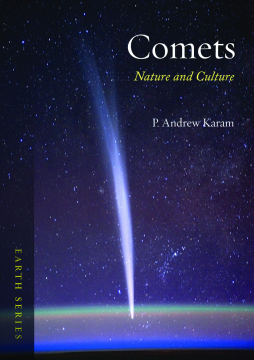
Additional Information
Book Details
Abstract
Radiating fire and ice, comets as a phenomenon seem part science, part myth. Two thousand years ago when a comet shot across the night sky, it convinced the Romans that Julius Caesar was a god. In 1066, Halley’s Comet was interpreted as a foreshadowing of the death of Harold the Second in the Battle of Hastings. Even today the arrival of a comet often feels auspicious, confirming our hopes, fears, and sense of wonder in the universe.
In Comets, P. Andrew Karam takes the reader on a far-ranging exploration of these most beautiful and dramatic objects in the skies, revealing how comets and humanity have been interwoven throughout history. He delves into the science of comets and how it has changed over time; the way comets have been depicted in art, religion, literature, and popular culture; and how comets have appeared in the heavens through the centuries. Comprehensive in scope and beautifully illustrated throughout, the book will appeal not only to the budding astronomer, but to anyone with an appreciation for these compelling and remarkable celestial bodies.
“‘Astronomical bringers of life and death’—this is how Karam characterizes comets (at least in the public imagination) in this very attractive and highly illustrated book. . . . It is part of Reaktion’s Earth series, each with the aim of drawing together science, art, literature, history and culture and the ways in which they have responded to a particular physical phenomenon. . . . It is glossy, full of excellent, diverse, interesting images and with just enough text, divided into standalone sections, to dip in and out of.”
— BBC Sky at Night Magazine
“Karam has a bright, breezy, and introductory approach. . . . He investigates the cultural influence of comets, and considers their role in art, fiction, fantasy, graphics, and astrological prediction. Here the book benefits from a host of superb illustrations and the author’s commendable writing ability. The influence of Halley’s Comet, and the effect of great comets on the likes of Julius Caesar and the Heaven’s Gate Cult enliven the text.”
— The Observatory
"Comets have intrigued people over the millennia, as shown by cave paintings and petroglyphs, tapestries from the Middle Ages, and Renaissance paintings. They may have been the carriers of life to Earth, transporting water and complex chemicals, and the bringers of death, impacting Earth and causing mass extinctions. Science writer Karam starts off his slim paperback with an explanation of where comets come from and what they are made of, moves on to discussions of comets’ scientific and cultural effects, and considers some of the most awe-inspiring comets observed to date. Filled with photos, paintings, drawings, and other illustrations, Comets is aimed at not only astronomers but anyone interested in learning more about what Karam has called 'some of the most fascinating objects in the solar system.'"
— Cynthia Cummings, Physics Today
P. Andrew Karam is a scientist, consultant, and writer living in New York City. He specializes in topics related to radiation protection and cosmic radiation.
Table of Contents
| Section Title | Page | Action | Price |
|---|---|---|---|
| Cover | Cover | ||
| Comets | 3 | ||
| Imprint Page | 4 | ||
| Contents | 5 | ||
| Introduction | 7 | ||
| 1. The Science of Comets | 11 | ||
| 2. Studying Comets through the Ages | 36 | ||
| 3. Visualizing Comets | 63 | ||
| 4. Comets and Religion | 87 | ||
| 5. Comets in Literature and Popular Culture | 106 | ||
| 6. History’s Greatest Comets | 137 | ||
| 7. Bringers of Life and of Doom | 164 | ||
| Conclusion | 186 | ||
| References | 189 | ||
| Select Bibliography | 192 | ||
| Acknowledgements | 194 | ||
| Photo Acknowledgements | 196 | ||
| Index | 198 |
